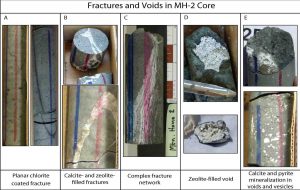
In their study published in Lithosphere this week, James Kessler and colleagues examine the geology of a scientific borehole drilled into the Snake River Plain, Idaho, USA, to investigate the potential for geothermal energy at depth. The site discussed in this paper is on the Mountain Home Air Force Base, where a drillhole in 1984 indicated that geothermal fluids were present at about 1.8 km depth.
With ARRA funding for new energy research and a grant from the International Continental Drilling Program, Kessler and colleagues drilled three 2-km-deep holes in the region. The Snake River Plain is the track of the Yellowstone Hotspot, and consists of rhyolite and basalt. Volcanic rocks near Yellowstone are quite young, whereas at Mountain Home, Idaho, the rocks are three to five million years old. Despite the abundant evidence for heat, the Snake River Plain does not produce geothermal energy due to a cool water aquifer present in the upper 500 m of the rocks.
The work reported in this paper is on the Mountain Home site, where waters of about 150 °C were encounter at 1745 m depth. Kessler and colleagues report on the geology of the basaltic rocks of the borehole, including determining the distribution of the basalts, the presence of faults and fractures at depth, and evidence for older hydrothermal interactions.
They also worked with geophysicists at the University of Alberta to determine the stresses at depth in the site. When holes penetrate rocks at depth, characteristic fractures form and their orientations can be used to determine the orientations of the stresses. The team reports that the maximum horizontal stresses here are at N 45°E, which suggests a complex geology at depth that might contribute to the localization of the geothermal fluids. Kessler and colleagues posit that these stresses are similar to the stresses observed in northern Nevada.
Another high point of this work is that this reports the results of James Kessler’s Ph.D. work; it also included two undergraduates, Mikaela Pulsipher and Fallon Rowe, and master’s student Jerome Varriale as co-authors.
Reference:
J.A. Kessler et al. Geology and in situ stress of the MH-2 borehole, Idaho, USA: Insights into western Snake River Plain structure from geothermal exploration drilling, Lithosphere (2017). DOI: 10.1130/L609.1
Note: The above post is reprinted from materials provided by Geological Society of America.










